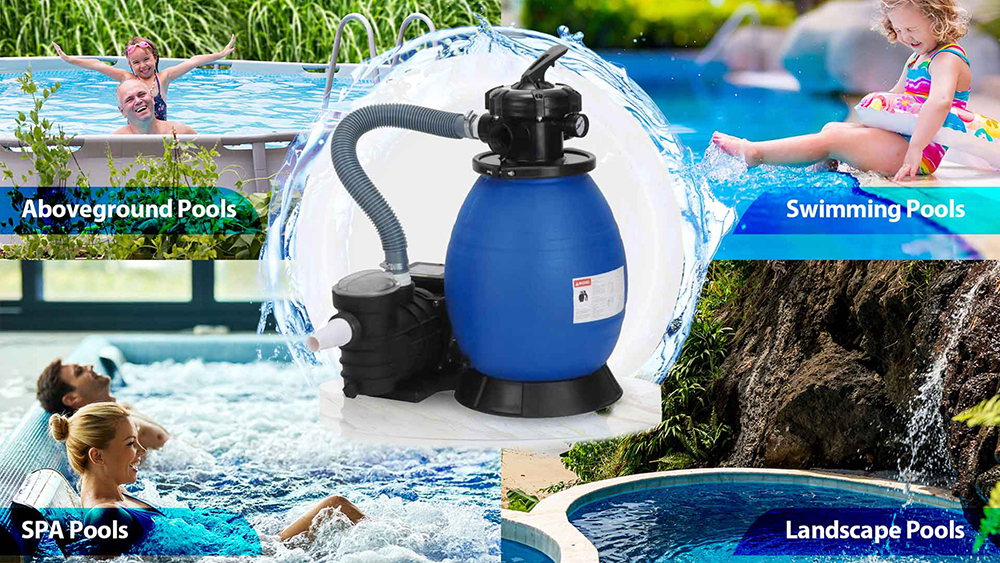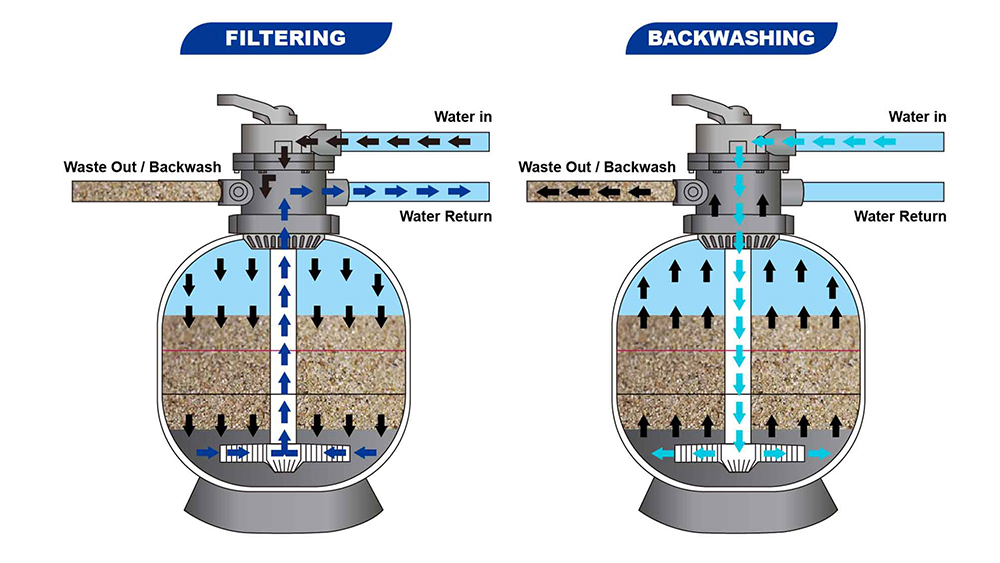+86 13816508465
Pump Introductions
Sep. 28, 2022

If you're managing a swimming pool, garden irrigation system, or a fish pond, you've probably heard of sand filter pumps. But how exactly do they work—and what makes them different from standard water pumps or standalone sand filters? In this guide, we'll break down the working principle of a sand filter pump, explore its key components, and help you decide whether it's the right solution for your water filtration needs.
A sand filter pump is used for family pools and SPAs to keep the pool water clean and free of particles. It is designed with quick assembly and precise components, making it easy to use for end users.
The filter tank is filled with special sand (generally quartz sand) and creates a filter bed inside.
Incoming water from the piping system will be directed automatically by the multi-function valve to the top of the filter bed. There are normally 5 working modes controlled by the top valve.
Understanding when and how to use each mode will help run the whole system more effectively.

sand filter pump diagram
FILTER
Under the FILTER position, the pool water containing suspended dirt and debris is pushed through the piping system and then guided by the control valve to the water outlet of the pool filter. The pool water flows through the filter bed, and the tiny dirt particles are removed. The filter bed captures dirt and filters out the clean water through the control valve and then returns it to the swimming pool. This whole set is continuous and automatic, and provides a complete circulation process for the swimming pool filter and pipeline system.
BACKWASH
When the sand filter is used for some time, the accumulated dirt will reduce the water flow. It has to be cleaned to improve the filter efficiency, then.
Check the pressure gauge at the top of the tank. When it reaches 8-10PSI above start-up pressure, start BACKWASH mode and the water will flow in the opposite direction.
The water flow will reach the bottom of the filter cavity and then backwash through the sand layer. The accumulated dirt will be washed up and discharged from the sewage outlet directly.
RINSE
After each backwash, the top valve should be fixed to the RINSE position. Start the pump to discharge the residue dirt in the sewage pipe, and then the top valve should be set to the FILTER position for regular filtering mode.
WASTE
The WASTE mode will drain the water through the sewage port and bypass the filter completely.
It will be used when you want to drain the excess water from the pools.
CLOSED
This is when you want to service or repair the sand filter pump.
NEVER run the sand filter when it is in the CLOSED position.
The sand filter pump mainly consisted of an oval-shaped filter tank, a pool pump, a multi-functional control valve, a pressure gauge, multi-hose adapters, water inlet and outlet, and a support stand.
Sand filter pumps provide a number of advantages for pool owners and small-scale irrigation users. From enhanced water clarity to long-term savings, these systems are a smart investment for clean and healthy water circulation.
1. Enhanced Water Clarity
Sand filters are highly effective at removing fine particles such as dirt, debris, and even algae. The result is cleaner, clearer, and more inviting pool water.
2. Low Maintenance
One of the standout features of sand filter pumps is their easy upkeep. Cleaning is done through backwashing, a simple process that can be performed by the pool owner—no special tools or replacement filters needed on a regular basis.
3. Cost-Effective in the Long Run
While the upfront cost may be similar to other filtration systems, sand filter pumps often offer lower operating costs. The filter media (sand) can last 5 to 8 years or more, significantly reducing maintenance expenses over time.
4. Durability and Longevity
Sand filter systems are built for long-term use. Their robust design typically results in a longer lifespan compared to cartridge filters, especially in outdoor or high-volume applications.
5. Ideal for Larger Pools
Thanks to their high flow capacity and consistent performance, sand filter pumps are well-suited for medium to large pools. They can efficiently handle larger volumes of water without compromising filtration quality.
6. Environmentally Friendly Option
While backwashing consumes some water, sand filters reduce the need for frequent filter replacements. In some cases, backwash water can be reused, making the system a more eco-conscious choice in the long term.
Sand filter pumps are primarily used for cleaning and circulating water in above-ground swimming pools. They are designed to filter out debris and other particles, keeping the pool water clear and clean. While they can be used for ponds, they are generally not ideal due to the biological activity and different filtration needs of ponds.
Here's a more detailed look:
Above-ground pools:
Sand filter pumps are a popular choice for maintaining the water quality in above-ground pools, especially those that remain assembled year-round.
Swimming pools:
Sand filters are a key component of pool filtration systems and are designed to remove debris and particles from the water.
Ponds (with caution):
While sand filters can be used for ponds, they are generally not recommended as the primary filtration method. Ponds have different filtration needs compared to swimming pools due to their biological activity and the types of debris they contain.
Water features:
Sand filters can also be used in other water features like fountains or water slides, where filtration is needed.
It's important to note that sand filters are not typically used for potable water filtration as they are not designed to remove bacteria or viruses.
To safely and efficiently use a sand filter pump for your pool, ensure proper installation, regular maintenance, and safe operation. This includes checking the pressure gauge, backwashing when needed, maintaining proper water flow, and understanding how the filter works. Always prioritize safety by turning off the pump before making any adjustments.
Here's a more detailed breakdown of tips for safe and efficient sand filter pump usage:
1. Proper Installation:
Match pump and filter flow rates: Ensure the pump's flow rate aligns with the filter's capacity to avoid damage or inadequate filtration.
Proper sand type: Use the correct type of filter sand recommended by the manufacturer for optimal performance.
Winterization: Drain the pump and filter if you live in a cold climate to prevent freezing and damage.
Initial backwash: After installation, backwash the filter for 3-5 minutes, followed by a rinse cycle for 1 minute, to remove any debris.
2. Regular Maintenance:
Backwashing: Backwash the filter when the pressure gauge rises 8-10 PSI above the normal operating pressure, or when you notice poor flow.
Frequency of backwashing: Backwash more frequently with heavy pool use and after vacuuming, filtering algae blooms, or using flocculant.
Sand replacement: Replace the sand every 3-5 years or sooner if the water remains cloudy despite normal backwashing.
Chemical balance: Maintain proper water chemistry to reduce strain on the pump and improve filtration efficiency.
3. Safe Operation:
Turn off the pump: Always turn off the pump before making any adjustments to the filter or connections.
Monitor pressure gauge: Regularly check the pressure gauge to identify potential issues and know when to backwash.
Avoid over-backwashing: Backwashing too frequently can reduce filter efficiency.
Clean the strainer basket: Regularly clean the pump's strainer basket to remove debris and maintain optimal water flow.
Check for leaks: Regularly inspect the pump and connections for leaks and address them promptly.
Safety equipment: Wear appropriate safety equipment when working with the pump and filter.
Yes. Sand filter pumps are ideal for garden irrigation systems where clean, debris-free water is essential. They're often used in small-scale agriculture and landscaping.
Typically, the sand should be replaced every 3 to 5 years, depending on usage and water quality.
Yes, many sand filter pumps are compatible with saltwater pools. Just make sure the materials are corrosion-resistant.
Consider your pool or system's volume (gallons or liters) and required turnover rate. A good rule is to circulate the full volume at least once every 8 hours.
Sand filter pumps are best suited for clean or slightly dirty water, such as from pools, tanks, or reservoirs. They're not designed for heavy sludge, thick mud, or industrial wastewater.
Yes. Many sand filter pumps are specifically designed for above-ground pools and are easy to install. Just ensure the pump flow rate matches the pool size.
Sand filters can remove algae particles, but if algae blooms are heavy, you may also need chemical treatment (e.g., chlorine) to kill the algae before filtration.
This depends on the pump model, but typical home-use sand filter pumps require 10–20 kg of silica sand.
Without regular backwashing, the filter will clog, reducing water flow and filtration efficiency. It may also strain the motor and shorten the pump's lifespan.
Some sand filter systems allow alternatives like glass media or zeolite, which may offer finer filtration. However, always confirm compatibility with your pump model.
Most sand filter pumps are relatively quiet, especially submersible or low-speed models. Excessive noise may indicate a clog, air leak, or motor issue.
Proble | Possible Cause | Solutio |
Low flow rate | Dirty sand / clogged pum | Backwash or clean pump basket |
Cloudy pool wate | Old sand or poor chemistry | Replace sand / balance wate |
Pump is noisy | Air leak or motor issu | Check connections / inspect motor |
Sand in pool | Broken laterals in filter | Replace laterals |
Whether you're maintaining a residential swimming pool, a SPA, or even a small-scale irrigation setup, a sand filter pump offers a durable, efficient, and low-maintenance solution for clean water circulation. As an all-in-one system, it combines advanced filtration with high-performance pumping, making it one of the best choices for domestic pool owners. Easy to clean, built to last, and simple to operate, a sand filter pump ensures a safer and cleaner water environment with minimal effort.
If you're looking to upgrade, explore the latest sand filter pump models from StreamPumps—engineered for convenience and long-term performance.
Address
No.17 XeDa Jimei Ind. Park, Xiqing Economic Development Area, Tianjin, China
Telephone
+86 13816508465
QUICK LINKS